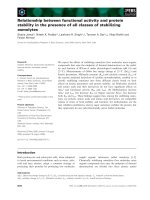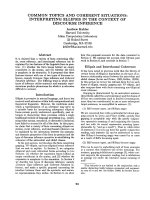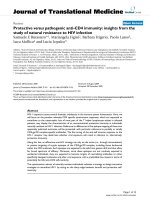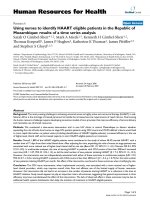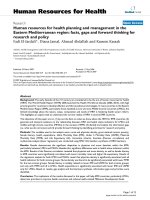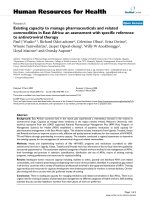báo cáo sinh học:" Using nurses to identify HAART eligible patients in the Republic of Mozambique: results of a time series analysis" potx
Bạn đang xem bản rút gọn của tài liệu. Xem và tải ngay bản đầy đủ của tài liệu tại đây (256.26 KB, 9 trang )
BioMed Central
Page 1 of 9
(page number not for citation purposes)
Human Resources for Health
Open Access
Research
Using nurses to identify HAART eligible patients in the Republic of
Mozambique: results of a time series analysis
Sarah O Gimbel-Sherr*
1,2
, Mark A Micek
2,3
, Kenneth H Gimbel-Sherr
1,2
,
Thomas Koepsell
1
, James P Hughes
4
, Katherine K Thomas
4
, James Pfeiffer
2,3
and Stephen S Gloyd
1,2,3
Address:
1
Department of Epidemiology, Box 357236, School of Public Health and Community Medicine, University of Washington. Seattle, WA
98195, USA,
2
Health Alliance International, 1107 NE 45th St, Ste 427, Seattle, WA 98105, USA,
3
Department of Health Services, Box 357660,
School of Public Health and Community Medicine, University of Washington, Seattle, WA 98195, USA and
4
Department of Biostatistics, Box
357232, University of Washington, Seattle, WA 98195, USA
Email: Sarah O Gimbel-Sherr* - ; Mark A Micek - ; Kenneth H Gimbel-
Sherr - ; Thomas Koepsell - ; James P Hughes - ;
Katherine K Thomas - ; James Pfeiffer - ; Stephen S Gloyd -
* Corresponding author
Abstract
Background: The most pressing challenge to achieving universal access to highly active anti-retroviral therapy (HAART) in sub-
Saharan Africa is the shortage of trained personnel to handle the increased service requirements of rapid roll-out. Overcoming
the human resource challenge requires developing innovative models of care provision that improve efficiency of service delivery
and rationalize use of limited resources.
Methods: We conducted a time-series intervention trial in two HIV clinics in central Mozambique to discern whether
expanding the role of basic-level nurses to stage HIV-positive patients using CD4 counts and WHO-defined criteria would lead
to more rapid information on patient status (including identification of HAART eligible patients), increased efficiency in the use
of higher-level clinical staff, and increased capacity to start HAART-eligible patients on treatment.
Results: Overall, 1,880 of the HAART-eligible patients were considered in the study of whom 48.5% started HAART, with a
median time of 71 days from their initial blood draw. After adjusting for time, expanding the role of nurses to stage patients was
associated with more rational use of higher-level clinical staff at one site (Beira OR 1.9, 95% CI 1.1–3.3; Chimoio OR 0.2, 95%
CI 0.1–0.5). In multivariate analyses, the rate of starting HAART in patients with CD4 counts of less than 200/mm
3
increased
over time (HR = 1.07, 95% CI 1.02–1.13), as did the total number of new patients initiating HAART (β = 7.3, 95% CI 1.3–13.3).
However, the intervention was not independently associated with either of these outcomes in multivariate analyses (HR = 0.9,
95% CI 0.7–1.2) for starting HAART in patients with CD4 counts of less than 200/mm
3
; (β = -5.2, p = 0.75) for the total number
of new patients initiating HAART per month. No effect of the intervention was found in these outcomes when stratifying by site.
Conclusion: The CD4 nurse intervention, when implemented correctly, was associated with a more rational use of higher-
level clinical providers, which may improve overall clinic flow and efficient use of the limited supply of human resources.
However, this intervention did not lead to an increase in the number of patients starting HAART or a reduction in the time to
HAART initiation. Study month appears to play an important role in all outcomes, suggesting that general improvements in clinic
efficiency may have overshadowed the effect of the intervention. The lack of observed effect in these outcomes may be due to
additional health systems bottlenecks that delay the initiation of treatment in HAART-eligible patients.
Published: 28 February 2007
Human Resources for Health 2007, 5:7 doi:10.1186/1478-4491-5-7
Received: 24 August 2006
Accepted: 28 February 2007
This article is available from: />© 2007 Gimbel-Sherr et al; licensee BioMed Central Ltd.
This is an Open Access article distributed under the terms of the Creative Commons Attribution License ( />),
which permits unrestricted use, distribution, and reproduction in any medium, provided the original work is properly cited.
Human Resources for Health 2007, 5:7 />Page 2 of 9
(page number not for citation purposes)
Background
Since 2002 there has been a clear international commit-
ment to expanding the availability of highly active antiret-
roviral therapy (HAART) in developing countries. The
increased political and financial support have resulted in
dramatic increases in the number of people in resource-
poor countries initiating HAART, reaching over 1.3 mil-
lion [1] by the end of 2005. Though the results of this
expansion have been significant, as of June 2006, only
23% of HAART eligible [2] patients in Sub-Saharan Africa
were taking antiretroviral (ARV) treatment.
HIV Care and treatment access is often limited in resource-
constrained countries because the health systems in the
process of scaling-up HAART are weak, and only recently
became oriented toward providing care for chronic dis-
eases. A lack of human resource capacity to handle the
increased service requirements of roll-out plans is an
important limitation of the public health sector [3-5].
Logistical and operational challenges exist which impede
poorer countries' abilities to train, absorb and retain ade-
quate numbers of health workers in public health sys-
tems. Political factors, such as macro-level fiscal policies,
which restrict hiring of public sector workers, have con-
tributed to the deterioration of human resource capacity
and inhibited the rapid scale-up of HIV care and treatment
[6,7]. New models of care provision are needed to
improve efficiency of existing health services that provide
HIV care and treatment including those which rationalize
the use of the limited higher level providers through the
maximum delegation of tasks within the formal health
care team.
In 2004, Mozambique joined a growing number of
resource-limited countries heavily affected by HIV/AIDS
that began scaling-up national, public sector HIV care and
treatment. As of January 2006, national targets were
within reach, with over 67,779 individuals enrolled in the
HIV-care system nationally, and over 20,805 individuals
on HAART [8]. However, in Mozambique, as in the rest of
sub-Saharan Africa, there is a severe shortage of qualified
clinical personnel, particularly physicians. In 2006, the
WHO carried out a global comparison, and classified
Mozambique as one of a select group of countries facing a
critical shortage of human resources for health, with a
density of just 3 physicians and 21 nurses per 100,000
population [9]. 2005 Projections estimated that four-
times the current number of doctors would be needed to
scale up HAART for all clinically eligible patients within
ten years in Mozambique [10]. This projection is only for
HAART and does not take into consideration the other
pressing needs of the country. In 2006, the two medical
schools in the country were far from meeting this demand
with only 52 new doctors graduating [11]. This shortage
of clinicians leads to severe system inefficiencies and bot-
tlenecks that can delay HAART scale-up. Although train-
ing of new personnel has been ongoing and a firm priority
of the government of Mozambique, the identification and
testing of innovative and flexible strategies to best utilize
existing health workers will be necessary to meet the
ambitious treatment targets set forth in the national HIV/
AIDS strategic plan. In addition, these human resource
strategies may provide useful lessons learned for other
developing countries with similar human resource and
patient flow challenges.
Previous to this study, all diagnostic and curative care
within the specialized HIV clinics was provided by physi-
cians or medical officers (for the purposes of this study,
the term 'MD/MO' includes both medical doctors and
medical officers). Nurses performed baseline clinical
assessments and ordered CD4 and other routine labora-
tory tests in compliance with the core competency guide-
lines developed for HIV service delivery by the WHO;
however, they were not authorized to stage patients using
WHO staging criteria or interpret CD4 lab results [12] (a
CD4 count measures how strong a person's immune sys-
tem is, how far HIV disease has advanced and helps pre-
dict the risk of complications and debilitating infections).
As a result, a large proportion of MD/MO visits occurred
with non-HAART eligible patients which decreased MD/
MO appointment availability for the sickest patients,
thereby reducing the capacity to start new patients on
HAART.
It was hypothesized that expanding the role of nurses to
stage patients using WHO staging criteria and interpret
CD4 lab results would lead to more rapid information on
patient status, more prompt identification of HAART-eli-
gible patients, fewer losses to follow-up, and ultimately
more rational use of limited staff time with higher-level
clinical providers (Figure 1). The aim of this study was to
discern whether the CD4 nurse intervention increased
MD/MO appointment availability and improved the rate
at which HAART-eligible patients start ARV treatment.
Methods
We conducted a time-series intervention trial in two HIV
clinics in central Mozambique. These two outpatient HIV
clinics were located within two large urban referral hospi-
tals in Beira and Chimoio, the capitals of Sofala and
Manica provinces, respectively. These cities lie on the
main transport corridor linking the port city of Beira with
the Republic of Zimbabwe, and are among the most
highly affected areas in terms of HIV prevalence in the
country, with the 2004 adult HIV prevalence estimated to
exceed 30% in Beira and 25% in Chimoio [13]. Together,
these clinics averaged 1600 patient visits per month, of
which 1300 were clinical visits and 300 were psychosocial
support visits. These HIV clinics were managed and staffed
Human Resources for Health 2007, 5:7 />Page 3 of 9
(page number not for citation purposes)
by the Mozambican Ministry of Health (MOH), and
received technical and financial assistance from Health
Alliance International (HAI), an international NGO with
over 18 years of experience providing support to the
Mozambican MOH. In June 2004, both sites began receiv-
ing MOH-procured antiretroviral (ARV) medicines that
were provided free to all HAART-eligible patients.
Staffing at both sites included physicians, medical officers,
nurses, social workers, pharmacists and HIV-positive
activists. Throughout the study period clinical staff met
weekly to discuss patient cases and care coordination. In
addition, a HAART eligibility committee, consisting of the
HIV clinic manager, MD/MOs, a social worker and a phar-
macist, met regularly (varying from daily to every 2 weeks)
to confirm HAART eligibility (using clinical and psycho-
social readiness guidelines) and to approve initiation of
therapy when appropriate.
The CD4 nurse intervention was defined as changing the
scope of work for nurses so that they were trained and
authorized to evaluate patients' eligibility for HAART
using CD4 counts and WHO staging criteria. All nurses
participating in the intervention were basic-level nurses
with two-years of initial training, and all had attended
standardized training on staging HIV-positive patients
using CD4 counts and WHO criteria. Prior to the interven-
tion, all HAART and non-HAART eligible patients went
through a triage nurse for baseline assessment and blood
draws for CD4 counts and were then sent to a MD/MO for
their CD4 results, clinical staging, and definition of their
next care and treatment steps. After the intervention, all
new patients went to the CD4 nurse for initial baseline
assessments and blood draws, and then returned to the
CD4 nurse to receive their results and undergo clinical
staging. Based on the evaluations made by the CD4 nurse,
patients were classified as HAART eligible or non-HAART
eligible. Depending on their classification, they were then
either sent on the 'HAART pathway' (which included
referral for appointments with MD/MOs, social workers
and other treatment support staff) or scheduled to return
to the CD4 nurse for periodic monitoring until deemed
HAART-eligible based on clinical and/or laboratory
parameters.
The theoretical model of this intervention (Figure 2) pos-
ited that the increased role of nurses would decrease the
number of non-HAART eligible patient referrals to MD/
Patient flow before and after interventionFigure 1
Patient flow before and after intervention.
BEFORE AFTER
(7/1/04-11/30/04) (12/1/04-4/30/05)
New Patien
t
New Patien
t
Triage Nurse CD4 nurse
(Order CD4 count) (Order CD4 count)
MD/MO CD4 nurse
(Interpret CD4 result/stage) (Interpret CD4 result/stage)
HAART-eligible Non-HAART eligible
(to HAART pathway)*
Return to CD4 nurse
*= MD/MO/Social worker/Activist
Human Resources for Health 2007, 5:7 />Page 4 of 9
(page number not for citation purposes)
MOs. This decrease in referrals would result in an increase
in the availability of MD/MO appointment time for
HAART eligible patients, which would increase the pro-
portion of MD/MO visits with HAART eligible patients
(outcome 1). It was hypothesized that increasing MD/MO
availability for HAART eligible patients, who otherwise
may have delayed access to the MD/MO, would allow
these sicker patients to move more quickly through the
HAART pathway to treatment initiation. Consequently,
we expected a decrease in time to start HAART for eligible
patients (outcome 2) and an increase in monthly HAART
enrollment (outcome 3).
Both sites formally introduced the 'CD4 nurse' interven-
tion in December, 2004. Patients who enrolled at the HIV
clinics, underwent initial CD4 testing, or started HAART
during the 10-month period between 1 July 2004 and 30
April 2005 were included in the study, with the first five-
month period constituting the 'before' period and the sec-
ond five-month period constituting the 'after' period.
During the 10-month period, inclusion in analysis was
defined – depending on the study question – as either
enrollment at the HIV clinic, starting HAART, or initial
CD4 blood draw.
All study subjects were adults of over 15 years of age. Pedi-
atric patients were excluded from this analysis, as CD4
nurses were not authorized to screen this subset of the
population.
Study data were derived from existing databases that are
maintained at each clinic site and include data routinely
collected as part of patient care. These data include basic
socio-demographic, clinical, laboratory and pharmacy
information for all patients, including the dates of enroll-
ment into the HIV clinic, the dates of all clinical appoint-
ments and CD4 tests and the dates of starting HAART.
Outcome 1
For the first outcome, the proportion of first visits to MD/
MOs made by HAART-eligible patients (those with CD4
counts lower than 200/mm
3
) was used to determine if the
intervention had the intended effect of limiting non-
HAART eligible patient visits to MD/MOs. To calculate
this indicator, we selected all adult patients who had ini-
tial visits with an MD/MO within 30 days of enrollment
at the HIV clinic, and determined the proportion of these
patients who were HAART-eligible at the time of their
visit. Only patients newly enrolling in the HIV clinics were
included in this analysis. Multivariate logistic regression
was used to determine the effect of the intervention after
adjusting for study month and site.
We determined the sensitivity and specificity of appropri-
ate referrals by nurses. Patients were categorized by their
CD4 counts at their initial visit (CD4 counts below 200/
mm
3
or CD4 counts above 200/mm
3
) and whether a MD/
MO visit was performed less than 30 days after enroll-
ment. The sensitivity of appropriate referral was calculated
among those with CD4 counts below 200/mm
3
and spe-
cificity was calculated among those with CD4 counts that
were above 200 or were unknown.
Outcome 2
For the second outcome, the rate of starting eligible
patients on HAART was compared before and after the
intervention. All adult patients with CD4 counts below
200/mm
3
on their first CD4 test between 1 July 2004 and
Theoretical model of CD4 nurse interventionFigure 2
Theoretical model of CD4 nurse intervention.
CD4 Nurse
Intervention
DECREASE INCREASE INCREASE DECREASE INCREASE
Non-eligible
HAART
patient
referrals to
MD/MOs
Available
MD/MO appt
time for
HAART
eligible
patients
% of MD/MO
visits by
HAART
eligible
patients
Time to start
HAART for
eligible
patients
Monthly
HAART
enrollment
Human Resources for Health 2007, 5:7 />Page 5 of 9
(page number not for citation purposes)
30 April 2005 were included in this analysis. Cox propor-
tional hazards regression was then used to compare the
hazard rates at which these patients started HAART before
and after the intervention, using the date of the initial
CD4 blood draw as the starting point for follow-up and
following patients through December, 2005.
Bivariate analyses using Cox proportional hazards regres-
sion was also used to evaluate the bivariate association
between the intervention and the promptness of starting
HAART, as well as with other variables (study site and
study month) hypothesized to potentially influence the
rate of starting HAART. A multivariate Cox proportional
hazards model was then created to estimate the independ-
ent effect of the CD4 nurse on the hazards of starting
HAART after adjustment for study month and site.
Outcome 3
The final analysis determined whether the introduction of
the CD4 nurse increased the monthly number of adult
patients starting HAART. The outcome was the number of
eligible patients started on HAART each month (count
variable), compared before and after the intervention. We
first evaluated the bivariate associations between the aver-
age number of patients starting HAART per month and the
presence/absence of the CD4 nurse intervention using lin-
ear regression. We also evaluated the bivariate association
between the number of patients starting HAART and the
study month and site. We then used multivariate linear
regression to determine the relationship between the
number starting HAART and the presence or absence of
the CD4 nurse after adjustment for both study site and
study month. Given the time delay inherent in starting eli-
gible patients on HAART, the intervention's effect on this
outcome may not have been immediate.
Covariates
Covariates were considered based on their theoretical
plausibility to affect the outcomes included in our analy-
ses. On this basis four main variables were considered as
covariates in adjusted analysis for each of the study ques-
tions, including the study site, the study month (a meas-
ure of the effect of time), the number of monthly MD/MO
visits (a measure of MD/MO capacity), and the number of
monthly new enrollees at the clinic (a measure of
demand). However, we chose to include study month and
study site in the final analyses since the number of
monthly MD/MO visits and the number of monthly new
enrollees did not improve model precision regarding the
effect of the CD4 nurse. Study month was included to
control for trends over time during the study period and
was defined differently for each of the three analyses. For
outcome 1 it was defined as the month of enrollment at
the HIV clinic; in outcome 2 it was defined as month of
initial CD4 blood draw; and in outcome 3 it was defined
as month of HAART initiation. Interactions between the
site and the CD4 nurse intervention and study month
were also tested for each outcome.
The study was approved by the institutional review boards
of the National Health Institute, Maputo, Mozambique
and the University of Washington, Seattle, USA. Data were
analyzed using SPSS version 13.0 (Chicago, IL) and
EpiInfo6 (Centers for Disease Control and Prevention,
Atlanta, GA).
Results
Overall enrollment was generally higher in Beira and
increased significantly over the study period (Table 1).
MD/MO Staffing increased significantly in Beira while in
Chimoio it did not. The number of new adult enrollees
and total adult MD/MO consults was higher in Beira than
Chimoio, and increased at both sites over time. The
number of adult enrollees with initial CD4 counts <200
mm
3
increased in both sites during the study period,
although as a proportion of total enrollees this increase
was only significant in Chimoio (27.6% pre-intervention
vs. 34.2% post-intervention, p = 0.002).
Outcome 1 – proportion of MD/MO visits by HAART
eligibility
In bivariate analysis, the proportion of MD/MO visits
with patients with CD4 counts under 200/mm
3
increased
significantly between the before and after periods at both
sites (Table 2). In multivariate analyses, there were signif-
icant interactions between site, intervention, and study
month (p ≤ 0.001, site × intervention and site × month
when simultaneously in the model) and therefore site-
stratified analyses were performed. In multivariate analy-
sis controlling for study month, the proportion of initial
MD/MO visits with HAART-eligible patients was signifi-
cantly higher after the CD4 nurse intervention in Beira
(OR 1.9, 95% CI 1.1, 3.3) while in Chimoio the effect was
reversed (OR 0.2, 95% CI 0.1–0.5).
At both sites, 1551 new enrollees had initial CD4 counts
under 200/mm
3
and 866 had visits within the first 30 days
after enrollment (sensitivity for appropriate visit = 0.56).
Sensitivity decreased at both sites between the pre and
post intervention periods (Beira pre/post 0.59 vs. 0.36;
Chimoio pre/post 0.77 vs. 0.68). Of 3376 patients at both
sites with initial CD4 counts under 200/mm
3
or
unknown, 2313 had no visit (specificity for appropriate
visit = 0.69). Specificity increased at both sites over the
study period, but the change was more dramatic in Beira
(pre/post 0.62 vs. 0.87) than in Chimoio (pre/post 0.52
vs. 0.61).
Human Resources for Health 2007, 5:7 />Page 6 of 9
(page number not for citation purposes)
Outcome 2 – rate of starting eligible patients on HAART
Of 1880 patients with initial CD4 counts below 200/mm
3
during the study period, 911 (48.5%) started HAART by
the end of December 2005 with a median time of 71 days
from their initial CD4 test. In bivariate analyses, all pre-
dictors were significantly associated with starting HAART
(Table 3). However, in multivariate analyses, only study
month and study site remained significantly associated
with time to starting HAART. There was no significant
interaction between the study site and the study month, or
between the study site and the introduction of the CD4
nurse intervention (data not shown).
Outcome 3: number of patients starting HAART per month
The number of new patients starting HAART per month
increased at both study sites throughout the study period
(Figure 3). In bivariate analysis, the number of patients
starting HAART was higher after the introduction of the
CD4 nurse intervention, but was also significantly associ-
ated with study month (Table 4). In multivariate analysis,
only study month remained significantly associated with
starting HAART. No significant interactions were found
between study site and either study month or the intro-
duction of the CD4 nurse intervention (data not shown).
Conclusion
In this study the CD4 nurse intervention was not posi-
tively associated with reduced time to HAART or increased
number of adult patients starting HAART per month.
However, our findings do suggest that the introduction of
the CD4 nurse intervention, when implemented correctly,
did increase the proportion of HAART-eligible patients
seen by MD/MOs. While not affecting the other outcomes
measured, the increased number of MD/MO appoint-
ments presumably improves the overall clinic flow and
efficiency of these providers particularly where their avail-
ability is less. In addition, when sensitivity/specificity
analyses were carried out we were able to conclude that
the proportion of non-HAART eligible (non-CD4<200/
mm
3
) patients that had medical visits lessened over the
study period.
In bivariate analysis, there were significant changes seen
in the three outcomes of interest. However, after control-
ling for secular trends in multivariate analysis, the inter-
vention's effectiveness disappeared. Study month appears
to play an important role in all outcomes, which suggests
that general improvements in clinic and system efficiency
were a source of improvements in outcomes over the
study period. These time trends may have obscured the
potential impact of the CD4 nurse intervention, and the
effect of the intervention may have been more apparent
had the study occurred later when the system was more
stable and enrollment into HAART more consistent.
One important limitation of this study is that external fac-
tors, such as health worker trainings, human resource
shifts and the influx of AIDS drugs, particularly in the
post-intervention period, likely impeded the study's abil-
ity to detect a significant impact of the CD4 nurse inter-
vention. For example, in Beira during month seven, there
was a large decrease in new patients starting HAART,
which we believe was due to factors beyond our control (a
social worker training, changes in clinic management dur-
ing the study period, etc.). The month-to-month random
variation in outcomes due to these external factors may
have obscured the impact of the intervention. In addition,
the data demonstrate that the overall workload is increas-
Table 1: Site characteristics
Site Pre-intervention
(7/04-11/04)
Post-intervention
(12/04-4/04)
p-value
Mean staffing-adult MD/MO (FTE) Beira 1.9 3.0 0.04**
Chimoio 1.9 2.0 0.42**
Mean no. of new HIV+ adults enrolled per month Beira 272 335 0.03**
Chimoio 172 216 0.14**
Mean no. of adult MD/MO consultations per month Beira 634 681 0.53**
Chimoio 528 686 0.08**
Mean no. of new adult enrollees with initial CD4<200 per month (<30 days after enrollment)* Beira 82 108 0.06**
Chimoio 47 74 0.04**
Proportion of new adult enrollees with initial CD4<200 (as proportion of all new adult enrollees) Beira 30.3% 32.3% .24±
Chimoio 27.6% 34.2% .002±
Mean no. of adult MD/MO consultations with new enrollees per month (<30 days after enrollment) Beira 143 414 .02**
Chimoio 142 860 .33**
Proportion of adult MD/MO consults with new enrollees (as proportion of all MD/MO adult consults) Beira 22.6% 12.2% <.001±
Chimoio 27.0% 25.1% .09±
* Only includes those enrollees not previously on HAART
**Based on t-tests to compare means
± Based on X
2
test of independence
Human Resources for Health 2007, 5:7 />Page 7 of 9
(page number not for citation purposes)
ing at both sites, as the proportion of visits with new
patients reduces and providers are increasingly inundated
with 'old' (previous) patients. With increasingly larger
numbers of 'old patients' being seen, the rate of starting
new patients on HAART (outcome 2) and the monthly
mean number of new patients put on HAART (outcome
3) will slow down as the system becomes overburdened.
One solution for this inundation will be the eventual
opening of new treatment sites in the vicinity which will
be able to absorb some of the overflow.
Another important limitation of the study is due to differ-
ential implementation of the intervention itself. The
results from the first outcome (the proportion of visits
with HAART-eligible patients) suggest that the implemen-
tation of the intervention may have occurred differently at
the two study sites. Discussions with clinic staff after the
data analysis was completed revealed that the complete
implementation of the intervention was delayed in Chi-
moio due to the absence of a key clinic advisor. This delay
may explain the differences between the effect of the inter-
vention in Chimoio and Beira.
Also, additional steps that occur after patient staging and
prior to HAART initiation may independently affect the
study outcomes and were not considered for this study.
These steps to initiate HAART include 1) attending several
sequential visits with social workers and other care pro-
viders, 2) passing through adherence building interven-
tions such as mandatory cotrimoxazole prophylaxis
regimens, and 3) case review and approval by a multidis-
ciplinary committee designed to improve coordination
and quality assurance. Delays at any of these steps may
mitigate the positive time gains resulting from the
increased MD/MO availability due to the CD4 nurse inter-
vention.
Finally, having the nurse interpret CD4 results and stage
patients only reduces visits to the MD/MO for patients
with high CD4 counts. For patients with low CD4 counts
the new system actually increases the number of patient
visits, since the patient must return to the MD/MO and
begin the further screening process. Therefore, a greater
positive effect may only be seen to the extent that the
patient population enrolls earlier on in their disease pro-
gression. As HAART continues to roll out in Mozambique
and the health system matures, a greater proportion of
earlier stage patients may enroll at treatment sites, which
may allow for sicker patients to more rapidly receive care
and treatment (through a more rapid movement from
HIV care enrollment to HAART initiation).
Further research is needed to address these aspects of the
study and confirm the effect of the CD4 nurse interven-
tion on clinic functioning and rate of HAART-eligible
patients initiating treatment. Future studies of this type
should be initiated only after the rate of starting patients
on HAART is stable to more clearly differentiate the
impact of the intervention from additional factors that
may affect the study outcomes. In addition, implementing
this study in sites with less MD/MO availability may be
more able to demonstrate improved efficiencies related to
the intervention. Future research should also endeavor to
simultaneously improve training and ongoing supervi-
Table 3: Time to starting HAART in adults by intervention, time and health service characteristics
Variable Bivariate Multivariate
HR (95% CI) p-value HR (95% CI) p-value
CD4 nurse Intervention (reference = before) 1.3 1.1, 1.4 0.001 0.9 0.7, 1.2 0.35
Study Month* 1.05 1.03, 1.08 < 0.001 1.07 1.02, 1.13 0.004
Study site (reference = Beira) 1.2 1.1, 1.4 0.002 1.2 1.1, 1.4 0.002
All Hazard Ratios (HR) and p-values determined through Cox proportional hazards regression
* Defined as date of patient's CD4 blood draw. Entered as a continuous variable from 1–10
Table 2: Proportion of first MD/MO visits with patients with CD4 counts <200/mm
3
, stratified by site
Site Variable Bivariate Multivariate
OR (95% CI) p-value OR (95% CI) p-value
Beira CD4 nurse intervention (ref = pre-intervention period) 2.2 1.6, 2.8 < 0.001 1.9 1.1, 3.3 0.03
Study month* 1.1 1.1, 1.2 < 0.001 1.0 0.9, 1.1 0.55
Chimoio CD4 nurse intervention (ref = pre-intervention period) 2.2 1.6, 3.0 < 0.001 0.2 0.1, 0.5 < 0.001
Study month* 1.3 1.2, 1.3 < 0.001 1.6 1.4, 1.8 < 0.001
All Odds Ratios and p-values determined through logistic regression
* Defined as patient's enrollment date in HIV clinic. Entered as a continuous variable ranging from 1–10
Human Resources for Health 2007, 5:7 />Page 8 of 9
(page number not for citation purposes)
sion for new interventions like the CD4 nurse as well as
quantify undefined system bottlenecks that contribute to
significant delays in initiating HAART for eligible patients.
Although many of these potential bottlenecks are
designed to assure quality and coordination of the care
team, and improve patient readiness for initiating HAART,
they may have the unintended consequence of signifi-
cantly delaying access to antiretroviral medicines.
Competing interests
The author(s) declare that they have no competing inter-
ests.
Authors' contributions
SOGS was responsible for the initial conception and
design of the data, participated in the data analysis and
drafted the original text. MAM participated in the data
analysis and made significant comments on progressive
drafts. MAM was supported in part through an STD/AIDS
Research Training Grant at the time that this study was
completed (NIH T32 AI 07140). KHGS participated in the
design of the study and made significant comments on
progressive drafts. KHGS is a Doris Duke Charitable Foun-
dation (ORACTA) grant recipient. TK provided input on
the design of the study and provided comments on pro-
gressive drafts of the manuscript. JPH and KKT provided
critical input in the data analysis and both made substan-
tive comments on progressive drafts. JP gave input on the
development of the discussion section and helped in the
revision of final drafts. SSG was instrumental in the initial
design of the study question and provided input on sub-
sequent drafts. All authors read and approved the final
manuscript.
Patients starting HAART by study monthFigure 3
Patients starting HAART by study month.
0
20
40
60
80
100
12345678910
Study month
Number started on HAART
Beira
Chimoio
Table 4: Associations between number of adults starting HAART and intervention, time, and health service site
Variable Bivariate* Multivariate
β (95% CI) p-value β 95% CI p-value
CD4 nurse intervention (reference = pre-intervention) 31.3 11.4, 51.2 0.004 -5.2 -39.4, 29.0 0.75
Study Month** 6.5 3.5, 9.5 < 0.001 7.3 1.3, 13.3 0.02
Study site (reference = Beira) -13.7 -38.0, 10.6 0.25 -13.7 -30.5, 3.1 0.10
All Odds Ratios and p-values determined through linear regression
* Bivariate analysis adjusted for site
** Defined as date of patient's HAART initiation. Entered as a continuous variable from 1–10
Publish with Bio Med Central and every
scientist can read your work free of charge
"BioMed Central will be the most significant development for
disseminating the results of biomedical research in our lifetime."
Sir Paul Nurse, Cancer Research UK
Your research papers will be:
available free of charge to the entire biomedical community
peer reviewed and published immediately upon acceptance
cited in PubMed and archived on PubMed Central
yours — you keep the copyright
Submit your manuscript here:
/>BioMedcentral
Human Resources for Health 2007, 5:7 />Page 9 of 9
(page number not for citation purposes)
Acknowledgements
The authors would like to acknowledge Dr. Armando Melo and Dr. Manuel
Nhumba from the Mozambican Ministry of Health who both provided crit-
ical input to the IRB application and commented on the final draft.
References
1. World Health Organization (WHO): Progress on global access to
HIV antiretroviral therapy. May 2006 edition. [http://
www.who.int/hiv/progreport2006_summary_en.pdf].
2. World Health Organization (WHO): Progress in scaling up
access to HIV treatment in low and middle-income coun-
tries, June 2006. UNAIDS [ />FS_Treatment_en.pdf].
3. Habte D, Dussault G, Dovlo D: Challenges confronting the
health workforce in sub-Saharan Africa. The World Bank–World
Hosp Health Serv 2004, 40(2):23-26.
4. Hosseinipour M, Kazembe P, Sanne I, van der Horst C: Challenges
in delivering antiretroviral treatment in resource poor coun-
tries. AIDS 2002, Suppl 4(16):177-187.
5. Kober K, Van Damme W: Scaling-up access to antiretroviral
treatment in southern Africa: Who will do the job? Lancet
2004, 364(9428):103-107.
6. Marchal B, Kegels G, De Brouwere V: Human resources in scaling
up HIV/AIDS programmes: just a killer assumption or in
need of new paradigms. Correspondance section of AIDS 2004,
18:2103-2105.
7. World Health Organization (WHO): Scaling up HIV/AIDS care:
service delivery & human resources perspectives. :5 [http://
www.who.int/hrh/documents/en/HRH_ART_paper.pdf].
8. Ministerio da Saude: DAM Boletim. Departamento da Assistencia
Medica 2006, 2(1):.
9. Ministerio da Saude: Reparticao de Estatística: Resumo dos
Funcionarios do SNS. Direccao de Recursos Humanos, Departa-
mento de Gestao e Planificacao 2003.
10. Smith O: Human resource requirements for scaling up anti-
retroviral therapy in low-resource countries. In Scaling up treat-
ment for the global AIDS pandemic Challenges and opportunities Edited
by: Curran J, Debas H, Arya M, Kelley P, Knobler S, Pray L. Washing-
ton, DC , The National Academies Press; 2005:292-308.
11. Cliff J: . Personal communication edition. . August 21, 2006
12. World Health Organization (WHO): Core competencies: Results
from the International Consensus Meeting on HIV Service
Delivery Training and Certification. [ />pub/meetingreports/Corecompmeetrep.pdf].
13. Ministério da Saúde: Relatório sobre a Revisão dos Dados de
Vigilância Epidemiológica do HIV. Ronda 2004. Maputo 2005.
